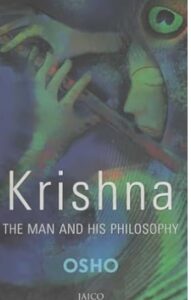Krishna: The Man and His Way of thinking is a significant investigation of the life and lessons of Krishna, perhaps of the most venerated figure in Hindu folklore and otherworldliness. The book, created by the spiritualist and otherworldly educator Osho, dives into the puzzling and diverse character of Krishna, depicting him as a total and freed person who exemplifies the embodiment of life, love, and shrewdness.

Krishna’s Life and Times
Krishna, accepted to have lived close to a long time back in old India, is a focal figure in the Mahabharata, quite possibly of the best Indian epic. He is revered as the eighth manifestation (symbol) of the god Vishnu, the preserver of the universe. Krishna’s life is portrayed through different stages, each noteworthy various parts of his personality. From his devilish youth in Gokul, where he charmed everybody with his heavenly perkiness, to his childhood in Vrindavan, where his affection for Radha and the gopis (cowherd young ladies) turned into the exemplification of heavenly love, Krishna’s life is an embroidery of dynamic and different encounters.
As a charioteer and manual for the champion Arjuna in the Kurukshetra war, Krishna conveyed the Bhagavad Gita, an otherworldly talk that typifies the embodiment of equitable living, caring activity, and commitment to the heavenly. This time of Krishna’s life features his job as a scholar and guide, offering shrewdness that rises above time and stays pertinent to the difficulties of present day life.
Theory of Krishna
Osho’s translation of Krishna’s way of thinking is both eccentric and illuminating. He presents Krishna as an image of a definitive union of life, where the material and profound universes are not in struggle but rather are amicably coordinated. Krishna, as per Osho, is the epitome of a completely submerged in individual life yet stays separated, an idea that is key to the way of thinking of Karma Yoga in the Bhagavad Gita.
Krishna’s way of thinking isn’t one of renunciation yet of complete acknowledgment of life in the entirety of its structures. He instructs that life ought to be lived with delight, immediacy, and a feeling of liveliness. This approach appears differently in relation to the customary austere view that frequently connects otherworldliness with withdrawal from common delights. Krishna’s message is one of equilibrium, where one can partake in the delights of the world without becoming oppressed by them.
SunshinStates | WebEverlast | WebEraEnterprise | InspirationIgnite | FusionForges | NexsNetwork | VibrantVentur | AscentAdvisores | websFrontiers | VistasVentures
Key Subjects
The Energy of Life: Krishna’s life is a festival of presence. His perky nature, as found in his connections with the gopis and his adoration for music and dance, represents the delight and immediacy that are vital to a satisfied life. Osho stresses that life ought to be resided as a leela (divine play), where each second is a chance for bliss and innovativeness.
Separation in real life: One of the center lessons of Krishna is the idea of Nishkama Karma, or sacrificial activity. He advocates for playing out one’s obligations without connection to the outcomes, which prompts freedom from the pattern of birth and passing. This thought is key to the Bhagavad Gita and is a foundation of Krishna’s way of thinking.
The Amalgamation of Alternate extremes: Krishna epitomizes the union of contrary energies — love and war, euphoria and distress, otherworldliness and realism. Osho makes sense of such Krishna’s reality is an example in embracing all parts of presence without judgment, making an agreeable harmony between the dualities of life.
Love as the Way to the Heavenly: Krishna’s adoration for Radha and the gopis is much of the time deciphered as a similitude for the spirit’s yearning for association with the heavenly. Osho expounds on this subject, introducing love as the most immediate and normal way to otherworldly arousing.
End
“Krishna: The Man and His Way of thinking” is in excess of a memoir; it is a profound and quick discourse on the quintessence of life as seen through the eyes of perhaps of the most darling figure in Hinduism. Osho’s translation of Krishna challenges ordinary otherworldly standards and urges perusers to embrace life in the entirety of its intricacy and excellence. Through Krishna, Osho offers a dream of a day to day existence resided in entirety, where bliss, love, and shrewdness are not discrete pursuits but rather interconnected parts of a solitary, dynamic presence.